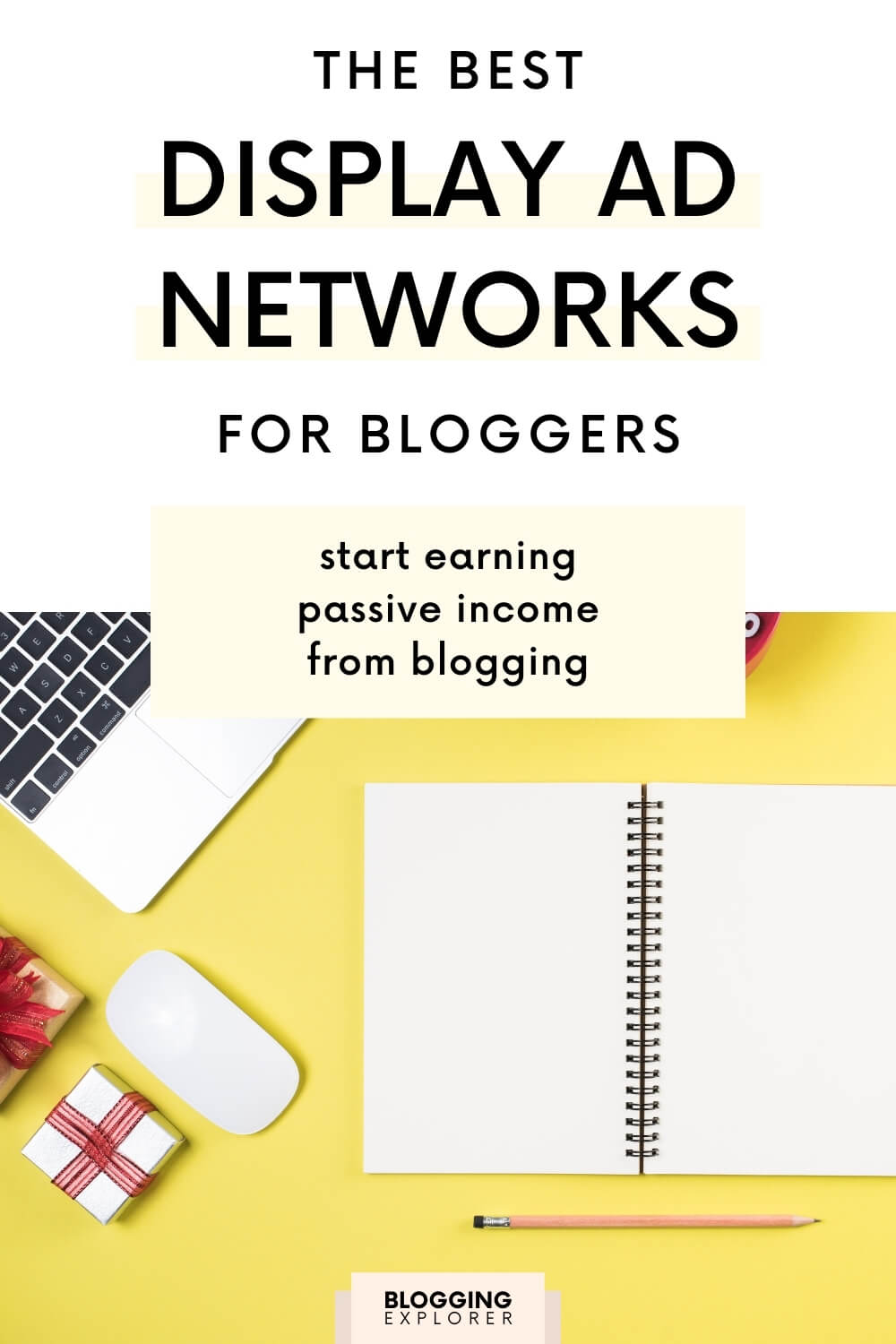Looking for the best ad networks for bloggers and publishers?
When you start a blog and promote it to grow your blog traffic, it’s time to think about how to make money from your blog.
Display ads are one of the easiest and most popular ways to make money blogging.
But if you want to make money with display ads, you can’t rely on selling ad space directly to businesses.
Instead, you need the help of a dedidated display ad network to connect you with a bigger pool of advertisers.
But how do you know which display ad network is the best for your blog?
Depending on how much traffic your blog attracts, you should choose a display ad network accordingly. Not all networks work the same way, let alone yield the same blog income.
To help you save time and make more money, in this post I’ll share the top ad networks you can use right now to increase your blog revenue.
I’ve only listed the best ad networks for publishers that are easy to set up.
And don’t worry if you’re just getting started with blogging. Even though your ad income is small in the beginning, using display ads means 100% passive income. You will literally earn money while you sleep.
Let’s go!
Here are a few related articles you may want to read:
- How to Increase Your Display Ad Income? 15 Smart Strategies for Bloggers
- 9 Critical Reasons Why You Should Start a Self-Hosted Blog
- How do display ad networks for publishers work?
- How do you make money from display ads?
- Remember this before you sign up for an ad network
- The best ad networks for bloggers and publishers in 2024
- Summary table: The best ad networks for publishers and bloggers in 2024
- FAQ: Ad networks for bloggers and publishers
- What is the best ad network for your blog?
- Final thoughts: The best ad networks for bloggers and publishers
Disclosure: This page contains affiliate links, meaning I receive a commission if you decide to purchase using my links, but at no additional cost to you. Please read my disclosure for more information.
How do display ad networks for publishers work?
Before we dive into the best display ad networks for bloggers and publishers, let’s take a look at how display advertising works.
If you’re a beginner, make sure you read my article on how to make money with ads on your blog.
In short, here’s how advertising works:
First, you have to start a blog and create high-quality, engaging content for your readers.
Next, you find an ad network to join and “sell” them advertising space on your blog.
That network works with a pool of advertising partners. Each partner wants to show their ads to a specific niche audience, such as your readers.
For example, an advertising partner might want to promote their gardening products. Hence, if you blog about gardening, that partner will be interested in showing ads to your readers.
The best part?
Once you’ve signed up with one of the top ad networks below, you don’t have to do anything. The network will manage your ads for you and make sure your readers see ad they are interested in.
Thus, ad networks do most of the heavy lifting for you. You simply need to choose a network and they’ll match you with the highest bidding advertisers. You can also control the number of ad units on each page or in each article.
But how do you make money with advertising networks exactly? Let’s take a look…
How do you make money from display ads?
Once you’re all set up with your ad network, it’s time to start making money.
Whenever your visitors see or click an ad on your blog, you’ll earn money.
Most ad networks for bloggers pay you in two different ways:
- Pay per click advertisements (PPC):
You will get paid only when your readers click on ads. - Pay per view (PPV) or impression ads:
You will generate passive income based on how many people see an ad on a given page on your blog.
Most often, pay per view (PPV) ads earn you a fixed revenue for a certain count of thousand or several thousand impressions.
So, when someone visits your blog, they may see several ads on a single page, right? The good news is that each seen advertisement counts as an impression. The more ad units a visitor sees, the more impressions and revenue you generate.
For the exact details, you should always check in with your ad network.
I’ve seen tons of different revenue models and sometimes the differences in revenue can be quite big. PPV ads can earn you anything between $1 to $15 per thousand impressions or even more.
Of course, inceasing your ad impressions helps grow your ad income. But remember: the more ads your readers see, the more likely they are to leave your website altogether. Nobody likes scrolling through a blog post with 20 ad units, right? Just something to keep in mind.
Now, let’s look at a few things you should keep in mind before choosing your ad network.
Remember this before you sign up for an ad network
Choosing the right ad network to partner with can mean a big difference in blog income in the long run.
Compare several networks before you sign up and set up display ads on your blog.
But what types of ad networks should you consider?
What makes a specific network better than others?
Broadly speaking, the best ad networks for bloggers and publishers have a few things in common:
- Their setup process is quick and beginner-friendly
- They are easy to contact for help
- They pay you a fair revenue share
- They offer support to help you grow your earnings
Always remember that you have the upper hand when working with ad networks. After all, they’re earning a share of your ad income, too.
If you’re not happy with how they’re treating your blog, you can always switch to another network. Trust me, no ad network wants to say goodbye to easy money made off of publishers’ content.
The best ad networks for bloggers and publishers in 2024
Here are the best ad networks for bloggers and small publishers:

1. Infolinks
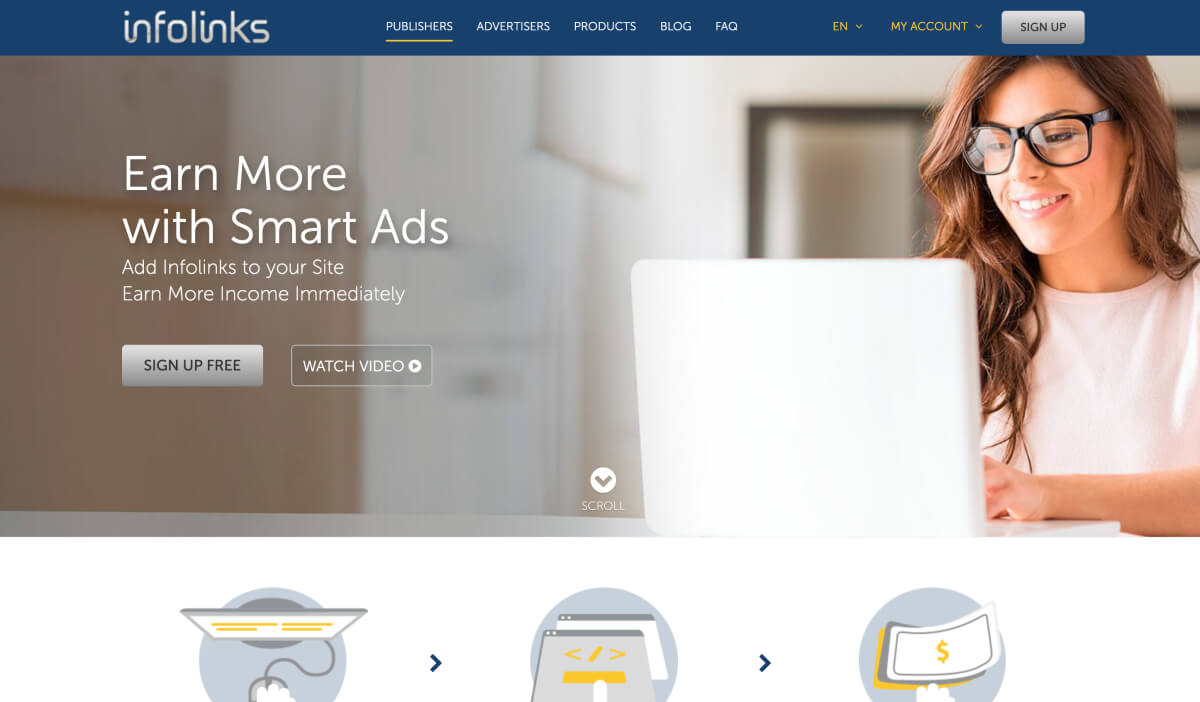
Infolinks is one of the top ad networks for bloggers big or small.
They help you monetize your blog by turning specific keywords within your content into clickable ad links. So rather than adding individual ad images and units to your blog posts, Infolinks looks for relevant keywords and matches their ads with them.
Additionally, Infolinks offers a few further ad types:
- Interstitials between page views
- Standard contextual ads
- Horizontal sticky ads at the top or bottom of your screen
- Vertical tall ads that take up any free white space at the sides of your screen
Infolinks has a super easy and quick signup process. You just need to enter your blog or website URL, enter your email address, and choose a password.
Once your application is approved, you will instantly get an email notification.
I received my welcome email just after 20 minutes and was able to log in to my dashboard.
Once you’re in, you can start customizing your ad units right away.
Keep in mind that it can take several days until all advertising partners of Infolinks have reviewed your site. That’s a standard thing, nothing to be worried about.
The partners will find the best ads to display on your site to make sure your earnings are as high as possible.
Pros of Infolinks:
- Powerful and yet rare ad units, such as their in-text ads
- Simple dashboard to track your earnings
- Option to receive your payout via bank transfer
Cons of Infolinks:
- Minimum payout is $50
- The dashboard feels a tad outdated
- Limited control over what keywords turn into links
2. Monumetric

Monumetric has been my go-to ad network for a while now with both my biggest blogs.
The best part: switching from AdSense to Monumetric increased my blog ad income by 1,000%. I’m not kidding.
For my full story, check out my Monumetric review article with all the details.
What’s best about Monumetric (formerly “The Blogger Network”) is the personal support you get when you sign up.
First, the friendly team at Monumetric will schedule a call with you to hear more about your monetization goals and to answer all your questions.
Based on your talk, they will come up with an ad revenue strategy for your blog.
Finally, they set up your site based on your goals. And when choosing ad placements, they are careful not to harm your user experience.
Hence, Monumetric does all the heavy lifting for you while you focus on creating valuable content for your readers.
To sign up with Monumetric, you need a minimum of 10,000 page views in 30 days. If you meet this requirement, Monumetric offers a free site audit and consultation. It’s a great opportunity to get started and talk to an expert.
If your blog is brand new, Monumetric may still be out of your reach. Just keep growing your traffic and helping your readers and you’ll hit that mark soon enough.
To grow your blog traffic quickly, follow my proven Pinterest traffic strategy guide.
When you are all set up, Monumetric will automatically allocate the ad space on your blog to the highest bidders. They have an extensive selection of advertisers in their network to match your blog topic and niche.
→ Sign up with Monumetric here
Pros of Monumetric:
- Personal support and help with the initial setup
- High income potential
- Large pool of advertisers
- Flexible ad placement
- 1-on-1 help for growing your income
Cons of Monumetric:
- Minimum traffic requirement: 10,000 page views in 30 days
- $99 setup fee with less than 80,000 monthly page views
- Slow payout schedule, net 60 days
3. Monetag
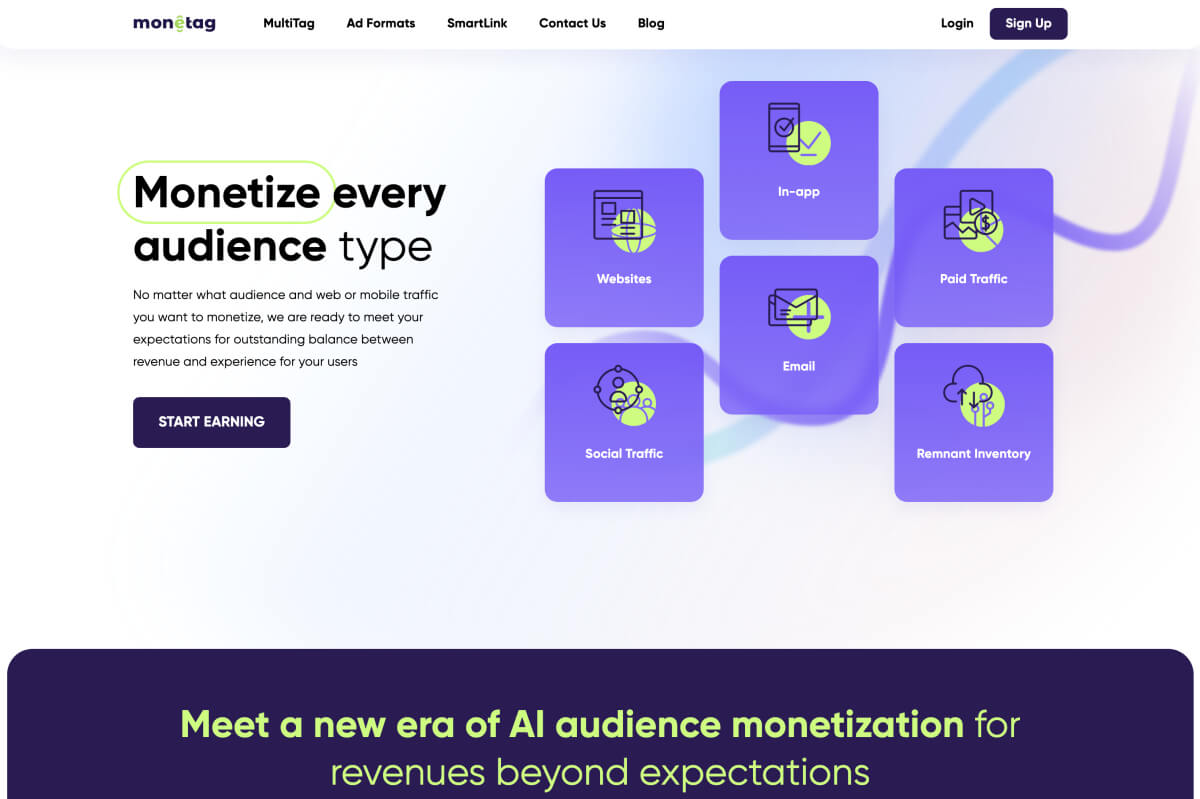
Monetag (previously PropellerAds) has one of the best ad unit selections for bloggers and other publishers out there.
Their banners, push notifications, onclick ads, interstitials, and smart links can boost your blog income in a myriad of ways.
Also, if you’re new to blogging, you can sign up with Monetag even with low blog traffic.
With their global advertiser network, you can monetize your blog traffic globally, not just in the US.
Moreover, with minimum payouts of just $5, you don’t have to wait to reach a high payout threshold. PropellerAds supports a wide selection of payout methods, too.
Pros of Monetag:
- Easy and quick sign-up process
- Worldwide ad coverage
- Clean and safe ads
- Wide selection of ad units, for both desktop and mobile
- Global advertiser coverage: monetize all traffic, not just US traffic
- Low minimum payout threshold: $5
Cons of Monetag:
- Popunder ads can be intrusive for your readers
4. Ezoic
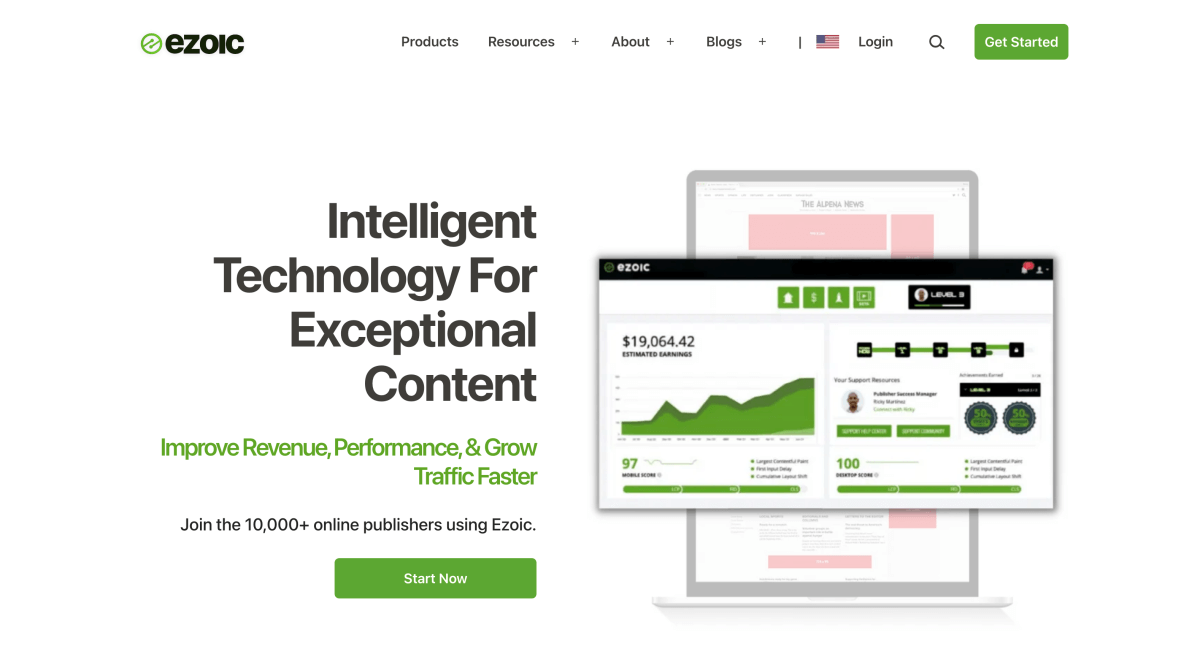
Ezoic is a great alternative to big display ad networks like Mediavine and AdThrive.
Their advertiser network is more diversified across different geographical locations and demographics.
Hence, if your blog traffic isn’t mainly from the U.S., Ezoic can help boost your ad income. If your traffic comes from all around the world, Ezoic can deliver ads that are relevant and interesting to all countries and readers.
Moreover, Ezoic comes with a user-friendly dashboard and great staff to answer your questions.
Joining this ad network is free and the setup is easy with the Ezoic WordPress plugin.
Just like AdThrive, Ezoic also is a Google Certified Publishing Partner. The main difference is that you can sign up with Ezoic with just 10,000 monthly visitors.
If your long-term goal is to grow your traffic to get accepted with AdThrive, Ezoic is a great network to team up with in the meantime.
Pros of Ezoic:
- Increased income for blog traffic outside the U.S.
- Easy-to-use publisher dashboard
- Massive advertiser network around the globe
Cons of Ezoic:
- Minimum traffic requirement: 10,000 monthly visitors
5. Google AdSense
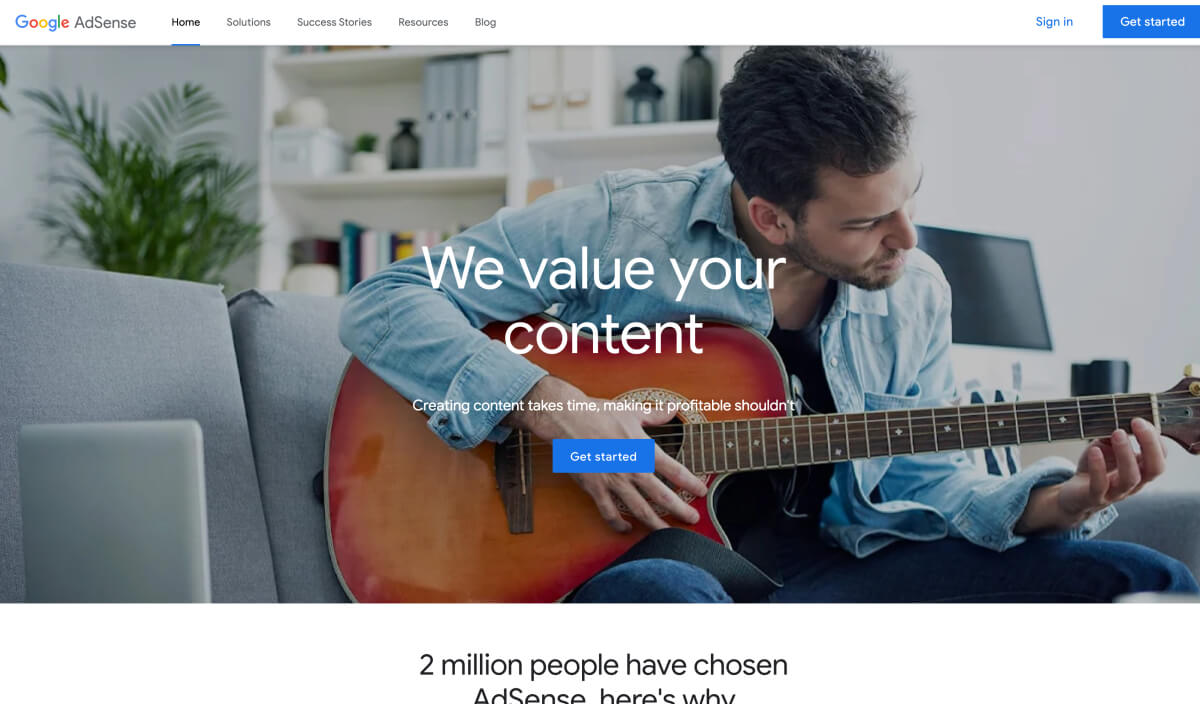
Google AdSense is probably one of the first ad networks you’ve heard of. It’s also the most popular display ad network on the WWW.
AdSense offers a wide range of different ad types for your blog. You have the power to choose where you want to display ads on your blog and how they should look.
Also, you can save a bunch of time by using Auto Ads. They will populate your blog automatically without you having to choose their locations separately. And if you don’t like a certain ad type or location, you can simply deactivate it in your auto ad settings.
However, AdSense has a minimum payout of $100. If your traffic is low, it might take you a long time to reach this threshold. Therefore, check your traffic volume before signing up with AdSense.
When you’re ready to join, watch their onboarding video series to learn the basics.
Pros of Google AdSense:
- Easy signup process
- Powerful reporting tools for performance monitoring
- Wide range of ad types
- Easy-to-use ad customization options
- Auto ads
Cons of Google AdSense:
- Minimum payout of $100
- Low income potential for small publishers
- Lack of “human” support
Recommended: 6 Top AdSense Alternatives for Low Traffic Blogs
6. Media.net
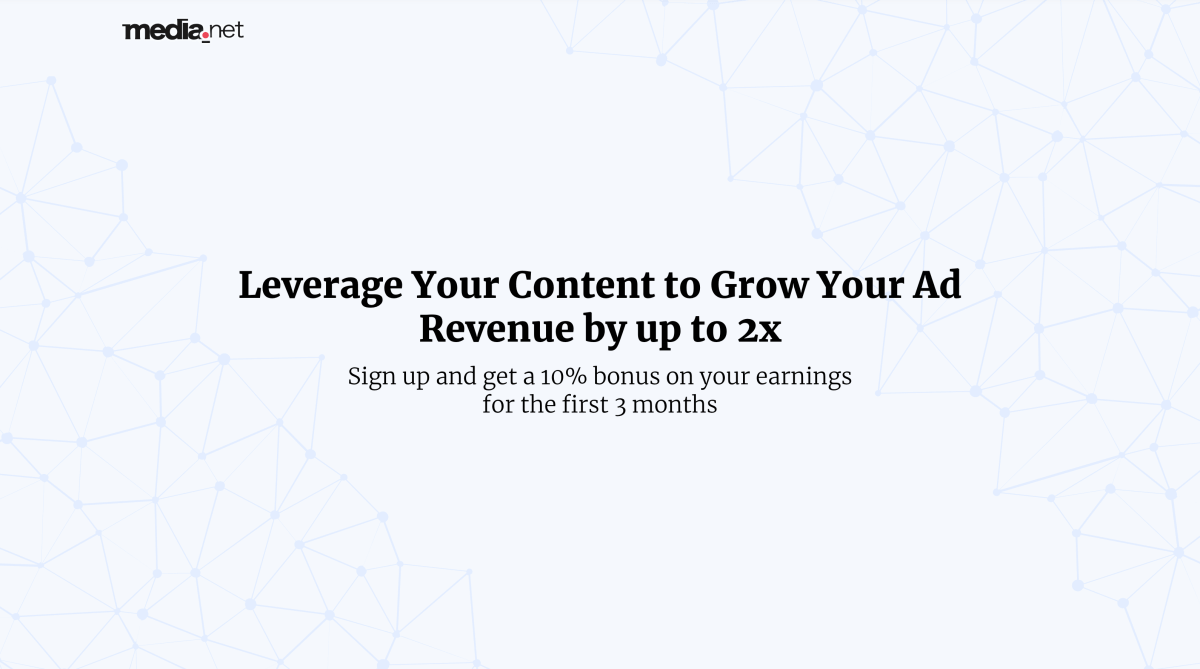
Another great ad network for publishers big or small, Media.net offers a nice selection of contextual ads.
The best thing about them is that they’re powered by Yahoo! and Bing so they have a seemingly endless number of advertisers to match your blog niche.
Media.net is also very easy to set up. However, they may need a couple of days to review and approve your blog. After that, you can access your publisher control panel and start creating ad units to display on your blog.
Keep in mind that the ad units at Media.net look quite different from any other network. You can easily customize their design to match the look and feel of your blog.
Media.net doesn’t have a minimum traffic requirement for publishers. Thus, you can sign up even if you don’t have lots of traffic just yet.
Once you’ve set everything up, you can let the ads run in the background and focus on creating new content for your readers.
Pros of Media.net:
- Easy to set up
- Large pool of advertisers
- Flexible ad unit design tools
Cons of Media.net:
- Minimum payout: $100
- Somewhat outdated look and design of ad units
- Relatively low revenue
7. Mediavine
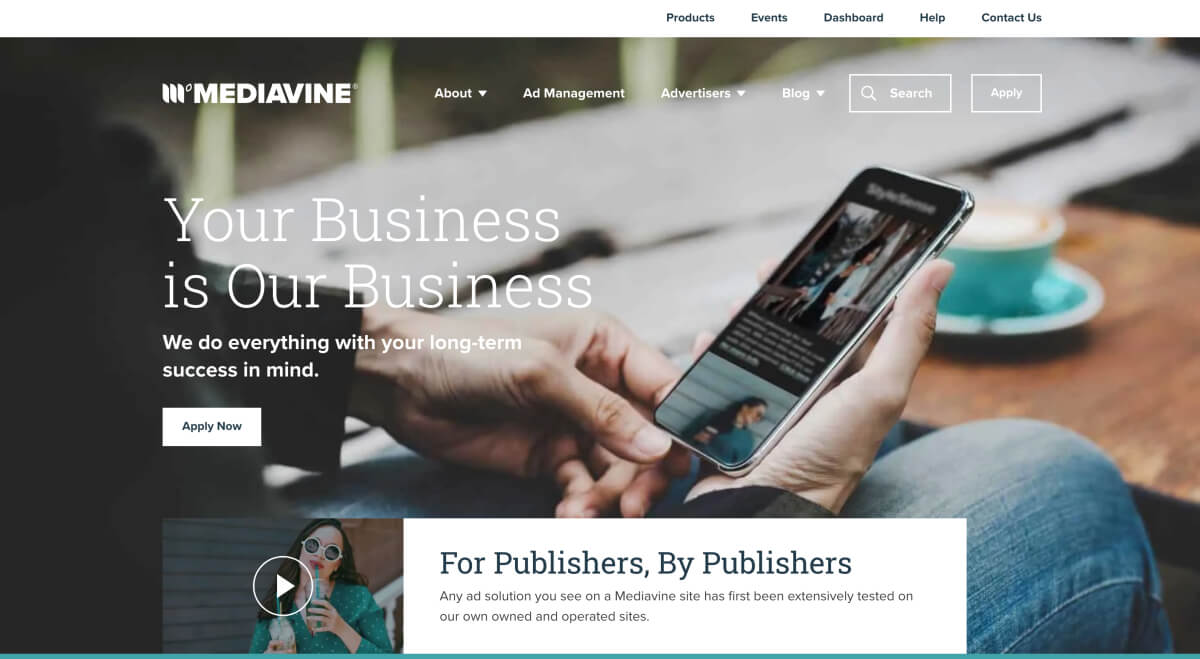
Mediavine is one of the best ad networks for bloggers much thanks to their earnings potential and personal support. It’s a popular blog ad network in lifestyle niches like beauty, food, fashion, and travel.
And while their minimum traffic requirement of 50,000 sessions per month is quite high, Mediavine is a great long-term goal to strive for.
If you’re thinking about joining Mediavine, check out my full guide on Mediavine requirements for all the details.
Mediavine boasts a faster, more user-friendly ad delivery method than most other ad networks for bloggers. Thus, your readers don’t have to wait for as long for the ads to be displayed.
Faster page loading speeds mean (1) more page views and (2) higher ad income.
Moreover, Mediavine has a large network of both publishers and advertisers. Therefore, you can always be sure that you’re selling your ad space to the highest bidders out there.
Mediavine is also transparent about their commissions: the pays content producers 75% of their ad sales while retaining only the leftover percentage.
If you’re in the lifestyle, fashion, food, or travel niche, Mediavine can boost your ad income particularly well.
Pros of Mediavine:
- High income potential
- Sponsored opportunities for publishers
- Supportive, helpful community
- Fast ad delivery method, improved page loading speed
Cons of Mediavine:
- Minimum traffic requirement: 50,000 sessions per month
Read next: The Best Mediavine Alternative for Bloggers (With High Earnings)
8. Raptive

Raptive (formerly AdThrive) is widely recognized as the best CPM-based ad network for bloggers with over 100,000 monthly page views. This ad network is popular in lifestyle niches like food, parenting, travel, and DIY.
I used Raptive (then AdThrive) on a blog with around 400-450k monthly readers in 2020 and none of the other ad networks I worked with come even close to their revenue potential. Another blog I managed for a client in 2023 saw similar results, but with a different seasonality.
Raptive is selective when it comes to new bloggers who want to join. But don’t let this scare you off. Just sign up on their website and see if you get approved.
If your blog doesn’t get approved, don’t hesitate to get in touch with them to ask why your application was declined. They may give you actionable steps to take to improve your chances of getting onboard in the future.
Raptive is incredibly helpful and supportive of their publishers. Their staff is well versed in the realm of publisher advertising and they’ve always made the effort to take their time and answer all my questions.
Also, they offer courses that can help you boost your RPM and earn even more passive income with your blog.
Pros of Raptive:
- Highest earning potential once you’re onboard
- Google Certified Advertising Partner
- Active and supportive community for tips and tricks
- Helpful staff to answer your questions
Cons of Raptive:
- Minimum traffic requirement: 100,000
9. Adversal
Adversal is a popular ad network for bloggers that allows you to earn money through content recommendations. Also, Adversal supports display and video ads.
What I like about Adversal is that they are fully GDPR compliant.
And all in all, their solution feels super easy. All you need to do is sign up, set up your ads, and not worry about anything.
Adversal requires you to have at least 50,000 page views monthly.
Pros of Revenue Hits:
- High earning potential, up to $50 per action
- No minimum traffic requirement
Cons of Revenue Hits:
- You need blog traffic that converts and takes action
- Impressions or clicks are irrelevant
10. Revcontent
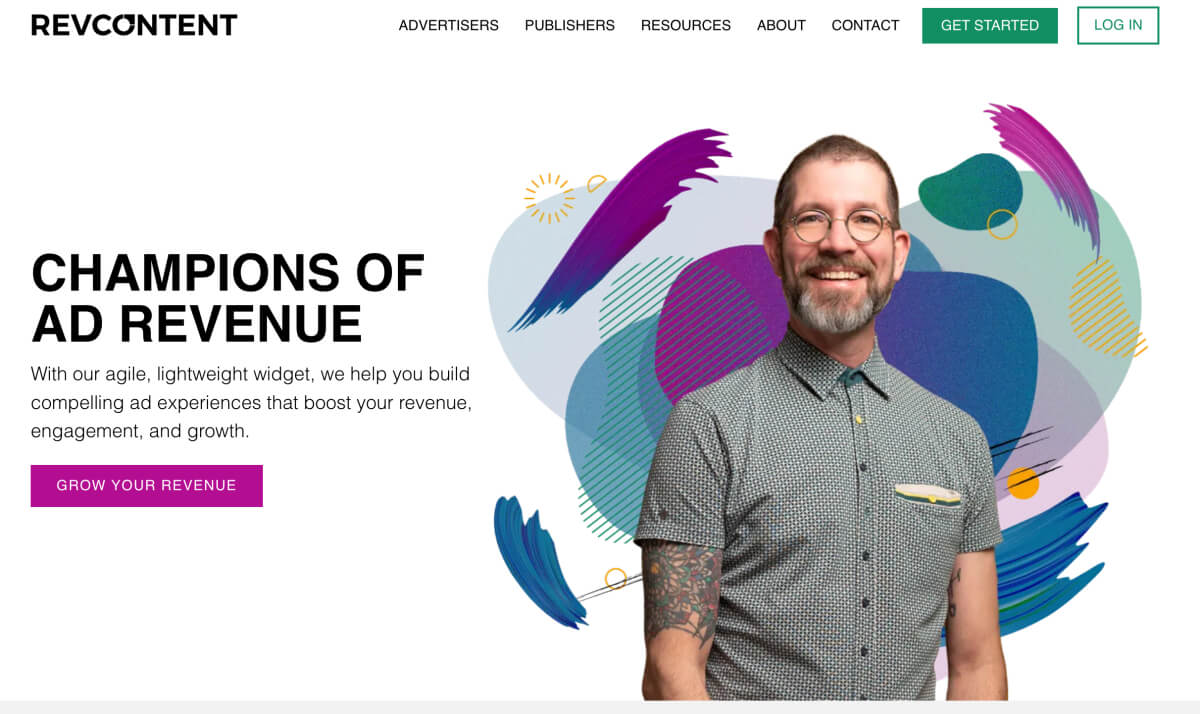
Revcontent is ad ad network that helps you monetize your content with content suggestions that appear below your blog posts.
This type of ad networks work well if you don’t want to place disruptive ad units within your blog posts.
Unlike a few other content suggestion networks, Revcontent doesn’t have a massive minimum traffic requirement. However, they are selective of the publishers they work with.
→ Sign up with Revcontent here
Pros of Revcontent:
- Lower minimum traffic requirement than with most other content suggestion networks
- Ad units aren’t as disruptive as static banners, pop-ups, or ads within your content
- Multiple placement options: after blog posts, in newsletters, video ads, etc.
- Minimum payout is just $100
11. Sovrn (formerly VigLink)
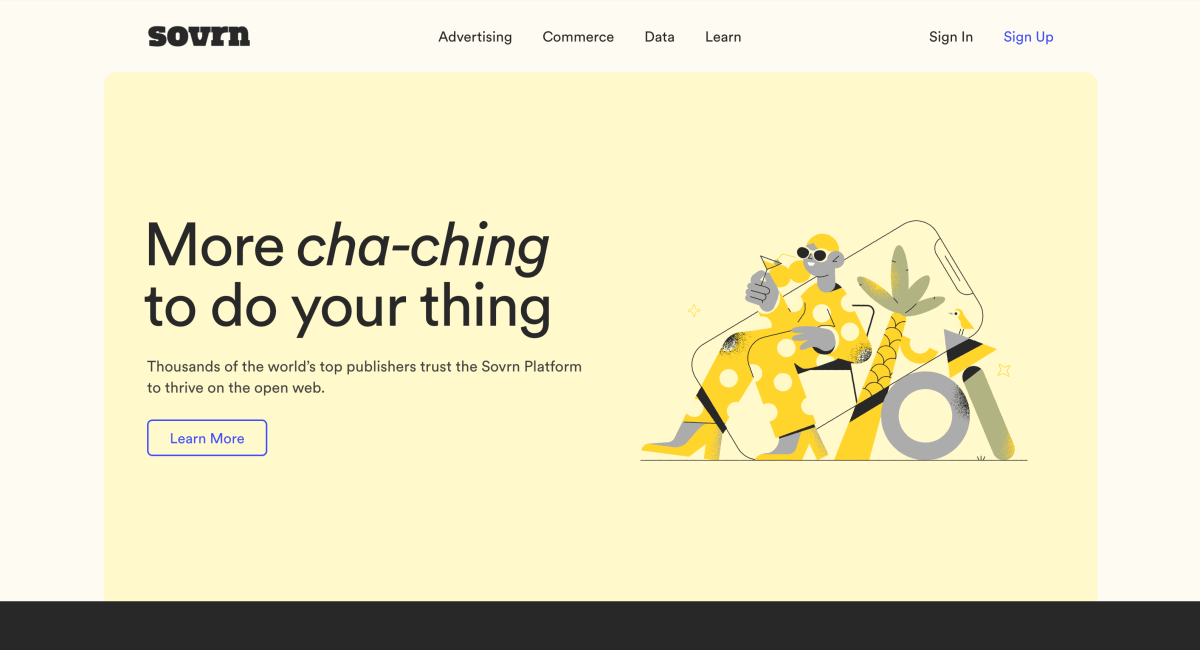
Sovrn is an ad network that works a lot like Infolinks: Sovrn scans your website content and automatically inserts contextual advertising links into your text.
Sovrn also offers a cool feature that allows you to automatically insert affiliate links into all of your existing blog posts.
Thus, if you sign up for an affiliate program now, you can easily add your affiliate links to older blogs posts, too.
All in all, Sovrn is an easy display ad network to start with, regardless of your blog niche.
The minimum payout at Sovrn is just $25. However, Sovrn pays publishers 90 days from the end of the month in which commissions were earned. Hence, you may have to wait for your payout for a while.
Summary table: The best ad networks for publishers and bloggers in 2024
| Ad network | Minimum traffic requirement | Payout threshold | Pros | Cons |
|---|---|---|---|---|
| Infolinks | none | $50 | Powerful and yet rare ad units; simple dashboard; quick signup | Outdated dashboard |
| Monumetric | 10,000 page views in 30 days | $100 | High income potential; personal support; large pool of advertisers | Slow payout schedule |
| Monetag | none | $5 | Easy and quick sign-up process; wide selection of ad units | Popunder ads can be intrusive for your readers |
| Ezoic | 10,000 monthly visitors | $5 | Increased income for blog traffic outside the U.S.; easy-to-use publisher dashboard | Minimum traffic requirement |
| Google Adsense | none | $100 | Easy signup process; powerful reporting tools | Low income potential for small publishers |
| Media.net | none | $100 | Nice selection of contextual ads | Low income potential for small publishers |
| Mediavine | 50,000 sessions per month | $25 | High income potential; sponsored opportunities for publishers | High minimum traffic requirement |
| Raptive | 100,000 monthly visitors | $25 | Highest earning potential; Google Certified Advertising Partner | High minimum traffic requirement |
| Adversal | 50,000 monthly pageviews | $20 | GDPR compliant; easy signup; supports video ads | High minimum traffic requirement |
| Revcontent | 50,000 monthly pageviews | $100 | High-quality ad units; good customer support | High minimum traffic requirement |
| Sovrn | none | $25 | Easy-to-use dashboard; friendly customer support | Low income potential for small publishers |
FAQ: Ad networks for bloggers and publishers
Ad networks are companies that connect advertisers with publishers, such as bloggers and website owners. They provide a platform for advertisers to place their ads on publishers’ websites, and they pay publishers a commission for each ad that is clicked or viewed.
There are several benefits to using ad networks for bloggers and publishers. These benefits include:
Earning passive income: Ad networks can help bloggers and publishers earn more money from their websites.
Simplified ad management: Ad networks can help bloggers and publishers manage their ads more effectively, which can free up their time to focus on creating content.
When choosing an ad network, consider these factors:
Your blog’s niche: Some ad networks specialize in certain niches, such as lifestyle or travel.
Your blog’s traffic volume: Some ad networks have minimum traffic requirements.
Your blog’s goals: Are you looking to maximize your income? Or are you looking for a more hands-off approach?
Some of the most popular ad networks for bloggers and publishers include Infolinks, Monumetric, Monetag, Google AdSense, Mediavine, Ezoic, and Raptive.
Here are a few tips for growing your display ad income: Choose a network that is a good fit for your blog or website niche and target audience. Place your ads strategically on your pages without damaging the user experience. Use a variety of ad formats to see what works best for your site. Monitor your ad performance regularly to identify bottlenecks and areas for improvement.
The amount of money you can earn from ad networks will depend on a number of factors, including your blog’s niche, traffic volume, and ad placement. In general, you can expect to earn between $1 to $20 per thousand page views.
There are a few things you can do to optimize your blog or website for ad networks, including: Create high-quality content that is relevant to your target audience. Increase your blog’s traffic volume to generate more ad views and clicks. Improve your blog’s user experience to make sure your visitors spend more time on your site.
What is the best ad network for your blog?
All of the ad networks we just covered will help you monetize your blog content regardless of your niche.
But their differences boil down to these two points:
- What ad format works best for you:
You want to achieve the highest possible RPM without negatively affecting the user experience on your blog website. - How much blog traffic you have:
While some ad networks require a minimum number of monthly visitors, others welcome all bloggers to join.
Even if your blog doesn’t have a ton of traffic, I encourage you to try display ads at some point. The income is 100% passive even if it’s not a fortune right off the bat.
Here are my suggestions:
If your blog is brand new, start with Infolinks or Media.net.
If you already have some traffic, join Monumetric. Their awesome team have helped me monetize my blogs since 2019, and I couldn’t have been happier with the results.
You can read more about my Monumetric earnings here.
If you blog about a lifestyle topic, such as fashion or cooking, consider joining Mediavine. They have quite a high minimum traffic requirement, though. If you’re not quite there yet, Monumetric is your best alternative.
Final thoughts: The best ad networks for bloggers and publishers
All in all, you can choose from dozens of best ad networks for bloggers out there.
At the end of the day, it boils down to the income potential and support you get from them. After all, you’re putting tons of effort into creating content and growing your traffic. That work deserves a fair return, right?
With that said, what you should always keep in mind is that you are in control.
You’re the one giving up space on your blog for others to advertise on.
You’re the platform that’s pairing businesses with potential customers.
Therefore, you’re also the boss when it comes to who you want to work with.
Whether you’re just starting out with blogging or your blog already has thousands of readers every day, this post should help you increase your blog income.
To get started, read my complete guide on how to make money with display ads on your blog.
If you found this post about the top ad networks for publishers and bloggers, please drop me a line in the comments below. I’d love to hear about your experience with display ads!
Have you monetized your blog with ads? How’s it been? Which ad networks have you used?
Related posts you may want to read, too:
- 6 Time-Saving Tips to Write Amazing Blog Posts Faster
- How to Quickly Find Your Blog Target Audience: The Ultimate Guide
- How Much Does It REALLY Cost to Start a Profitable Blog?
